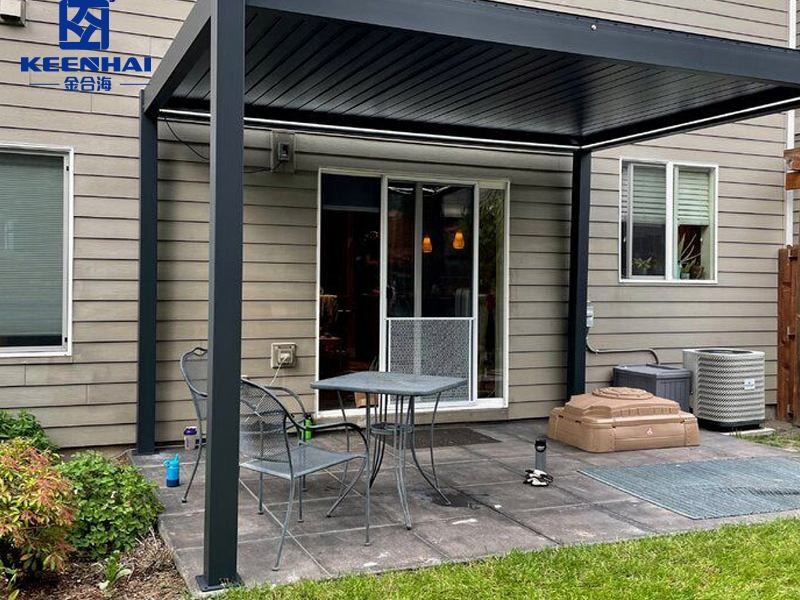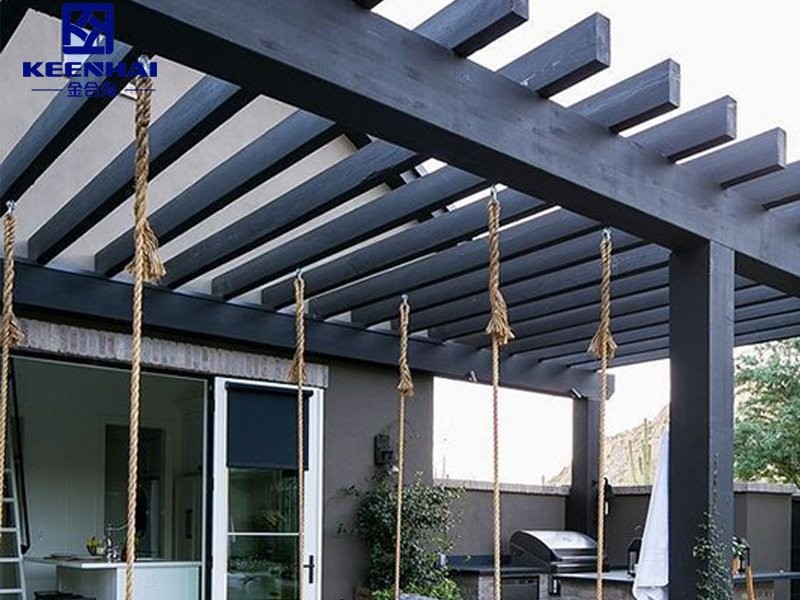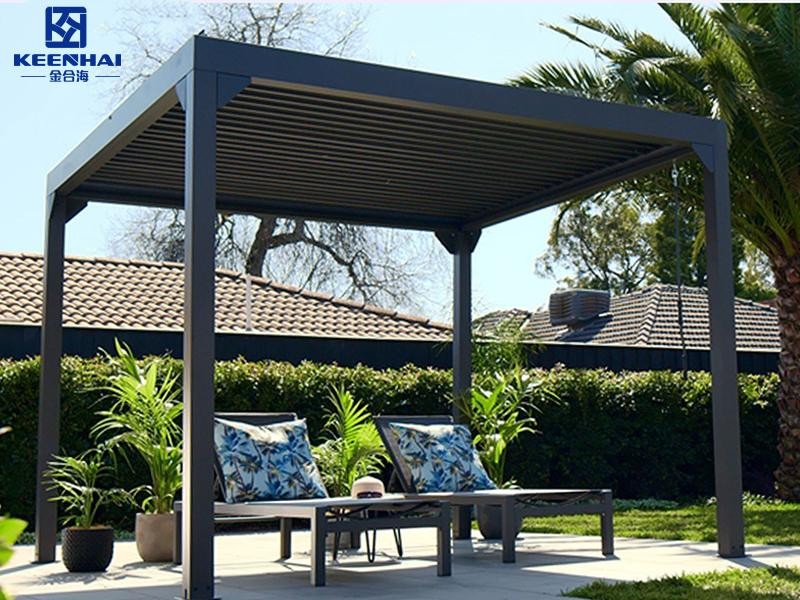
Key Benefits of an Adjustable Roof Pergola for Patios
1.1 Year-Round Outdoor Comfort
Installing an adjustable roof pergola transforms a patio into a space you can enjoy in every season. By simply adjusting the louvers, homeowners can block direct summer sunlight or allow warmth during cooler months. Research from the American Society of Landscape Architects shows that 76% of homeowners list "year-round usability" as a top reason for upgrading outdoor living spaces.
During hot summer afternoons, you can tilt the louvers to a closed position, reducing surface temperatures on the patio by up to 15°C. In winter, angling the panels upward allows low-angle sunlight to warm the area naturally, extending the usability of your outdoor furniture without extra heating. This control means you never have to cancel a barbecue due to light rain or blazing sun.
Patio designs with integrated heating elements and ceiling fans inside the pergola structure can further boost comfort levels. Homeowners in coastal areas often add wind-resistant side screens to block chilly gusts while still enjoying the view. Every adjustment directly affects how you use the space—morning coffee in soft sunlight, evening drinks under a rain-protected canopy, or a midday nap in cool shade.
1.2 Flexible Sunlight and Shade Control
An adjustable roof pergola offers precision control over how much light or shade reaches your patio. The system typically uses motorized louvers that rotate between 0° and 150°, letting you fine-tune conditions throughout the day. You can shift from full shade to partial light in less than 30 seconds.
The table below shows how different louver angles affect sunlight and temperature:
| Louver Angle | Sunlight Exposure | Average Temperature Change |
|---|---|---|
| 0° (Closed) | 0% direct light | -15°C cooler |
| 45° | 50% filtered | -7°C cooler |
| 90° | Full sunlight | 0°C |
| 120° | Morning sunlight | +5°C warmer |
For example, during a summer lunch, setting the louvers to 0° keeps the patio comfortable even under strong midday sun. In the early evening, opening them to 120° lets you capture the last warm rays without glare.
Some premium designs, like the Aluminum electric pergola, integrate light sensors that automatically adjust the roof when clouds pass or when the sun changes position. This automation prevents overexposure to UV rays while maintaining consistent comfort. Homeowners with vegetable or flower planters on their patios often use partial shade settings to protect plants from scorching heat while still allowing enough light for growth.
1.3 Enhanced Aesthetic Appeal
An adjustable roof pergola serves as both a functional structure and an architectural statement. Its clean lines and customizable finishes allow it to blend seamlessly with modern, rustic, or Mediterranean patio designs. Adding a pergola instantly elevates the perceived luxury of an outdoor area.
Many homeowners choose powder-coated aluminum frames in colors that match window trim or decking. Others opt for contrasting tones to create a focal point—white louvers against a charcoal frame, for instance. Integrated LED lighting strips hidden in the louver edges create an ambient glow for evening gatherings without the need for bulky fixtures.
The design flexibility extends beyond colors. For a truly bespoke look, you can combine the pergola with stone columns, timber accents, or retractable side curtains. A Retractable Pergola hybrid design adds the ability to slide open entire roof panels for an unobstructed sky view. This blend of aesthetics and versatility makes the pergola feel like a natural extension of the home, rather than an add-on.
1.4 Increased Home Value
Real estate surveys consistently show that outdoor living upgrades offer some of the highest returns on investment. According to a 2024 Zillow report, well-designed patio covers can boost property resale value by up to 12%. An adjustable roof pergola from brands like keenhaipergola not only enhances lifestyle but also acts as a selling point in competitive housing markets.
Buyers increasingly look for functional outdoor spaces that require minimal upkeep. Unlike wooden structures that need frequent sealing, aluminum-framed pergolas resist corrosion, fading, and warping, even in coastal climates. This durability reassures potential buyers and reduces long-term maintenance costs.
When appraisers assess property value, they consider permanent structures like pergolas as part of the home’s livable space, especially if the area includes built-in seating or an outdoor kitchen. Homes with integrated Aluminum retractable gazebo features often stand out in listings, drawing more viewings and offers.
For homeowners planning to sell within the next 5–10 years, installing a high-quality adjustable roof pergola can be a strategic investment. Not only does it create immediate enjoyment, but it also positions the home as a premium option for future buyers.

Functional Advantages for Patio Spaces
2.1 Protection from Rain and UV Rays
A well-built adjustable roof pergola shields your patio from both heavy rain and harmful UV exposure without sacrificing style. Modern louver systems use watertight seals that direct rainwater into hidden gutter channels, keeping the area beneath completely dry. During a sudden downpour, the louvers can close fully in under 10 seconds, allowing you to continue dining or relaxing without interruption.
Studies from the Skin Cancer Foundation confirm that high-quality aluminum louvers with powder-coated finishes can block over 90% of UV radiation, helping protect skin and prevent furniture fading. This level of protection is particularly valuable for patios with upholstered seating, wooden decking, or outdoor rugs that degrade quickly in direct sunlight.
Some homeowners upgrade to designs similar to an Aluminum electric pergola, which can integrate automated rain sensors. When the first drops hit, the system closes automatically, eliminating the need to rush outside during a storm. In climates with intense summer sun, many owners keep the louvers angled at 45° for filtered daylight, creating a comfortable space that remains bright but not scorching.
2.2 Improved Ventilation and Airflow
Unlike solid patio covers that trap heat, a louvered pergola maximizes airflow. When the louvers are partially open—typically between 90° and 120°—hot air naturally escapes upward while cooler air circulates at seating level. This chimney effect can reduce the perceived temperature by up to 8°C, according to outdoor comfort studies conducted by the University of Sydney.
For example, during a humid evening, opening the louvers slightly lets rising heat dissipate while still offering partial rain protection. Homeowners in tropical or coastal regions often pair this design with side screens to block horizontal rain while keeping airflow intact.
Some designs, like the Retractable Pergola, go further by allowing entire roof sections to slide open, giving you a full sky view and maximum ventilation when the weather is favorable. This flexibility turns a static patio into a dynamic space that adapts instantly to changing conditions, whether you’re hosting a crowded dinner or enjoying a quiet breeze alone.
2.3 Low Maintenance Requirements
Patio structures face constant exposure to sun, rain, and seasonal temperature shifts, but high-grade aluminum pergolas require minimal upkeep compared to wooden or steel alternatives. Brands like keenhaipergola use corrosion-resistant aluminum frames with UV-stable powder coatings, which resist fading and peeling for over 15 years with basic care.
Routine maintenance generally involves three steps:
-
Rinse the louvers and frame with a low-pressure garden hose every few months to remove dust and pollen.
-
Use a mild detergent and soft brush to clean stubborn dirt without scratching the finish.
-
Inspect the gutter system annually to ensure leaves or debris haven’t blocked water flow.
Unlike timber pergolas, there’s no need for sanding, sealing, or repainting. Even the moving parts—like louver pivot points—are designed with stainless steel components to prevent rust. This low-effort upkeep appeals to homeowners who want a high-end outdoor feature without committing to constant repairs. In fact, maintenance costs for an aluminum pergola average 60–70% less over a decade than for a comparable wooden structure, making it a smart long-term investment.

Popular Adjustable Roof Pergola Styles
3.1 Modern Minimalist Designs
A modern minimalist adjustable roof pergola focuses on clean lines, neutral tones, and unobtrusive hardware. Most homeowners who choose this style are looking for an outdoor feature that feels like an extension of their living room rather than a separate garden structure. The louvers are often slim, powder-coated in matte black, white, or deep charcoal, giving the pergola a sleek architectural edge.
This style works particularly well with glass sliding doors or frameless folding panels, blending the indoor and outdoor spaces. Many homeowners integrate recessed LED strip lighting along the louver frames so that the pergola looks just as sharp at night. A motorized louver system is common here, allowing fingertip control via a remote or app, so the roof adjusts seamlessly to changing light conditions.
If you want this modern look but also value all-weather usability, an Aluminum electric pergola with rain sensors and hidden drainage channels can maintain the minimalist design without bulky external gutters. The trick is to keep decorative clutter to a minimum—think low-profile outdoor seating, concrete or porcelain pavers, and monochrome planters.
3.2 Traditional Louvered Roof Look
The traditional louvered roof pergola brings a timeless feel while integrating modern engineering. Typically, the louvers are wider and the frame features classic profiles, such as beveled edges or decorative end caps. Warm colors like cream, sand, or soft brown give the structure a homely, welcoming appeal that complements brick patios and garden borders.
This style appeals to homeowners who love symmetry and order. Louvers are often manually operated with a crank or lever, keeping the experience tactile and simple. To maximize authenticity, some people choose faux-wood aluminum finishes, which provide the charm of timber without the constant upkeep.
When paired with climbing plants like wisteria or jasmine, the result is a shaded retreat that feels like it has always been part of the garden. A high-quality adjustable roof pergola in this style can still offer advanced features—hidden gutter systems, integrated lighting—but without losing its old-world charm. For many, it’s the balance between heritage aesthetics and the durability of modern materials that makes this design so appealing.
3.3 Rustic and Natural Wood Finishes
Rustic adjustable roof pergolas create a warm, organic atmosphere that blends beautifully with natural surroundings. While solid wood remains a popular choice, many homeowners now opt for aluminum frames with wood-grain powder coating. This option delivers the visual richness of cedar or oak but resists warping, cracking, and insect damage.
To achieve a truly rustic look:
-
Choose louvers with a slightly textured finish to mimic hand-sawn timber.
-
Use earthy tones like walnut, driftwood, or chestnut for the frame.
-
Pair with natural stone flooring or reclaimed brick pavers.
This style is perfect for countryside homes, lakeside retreats, or even urban patios that want a touch of nature. When integrated with elements like hanging lanterns, outdoor fireplaces, and planters filled with tall grasses, the pergola becomes a year-round focal point.
Some rustic models also come in retractable formats, such as an Aluminum retractable gazebo, which allows you to open the roof fully for stargazing nights while maintaining the warmth and character of a traditional wood-inspired design during the day.
3.4 Custom Color and Material Combinations
For homeowners who want a truly personalized space, custom color and material combinations offer endless possibilities. Modern manufacturing allows aluminum frames to be powder-coated in hundreds of shades, from bold coastal blues to muted desert tones. Louvers can be finished in a contrasting color to create a two-tone effect, or matched for a seamless look.
Material choices extend beyond standard aluminum. Some designs integrate tempered glass panels between louvers for filtered daylight, while others use composite inserts to add texture. The combination of keenhaipergola engineering and tailored finishes ensures the pergola doesn’t just fit the patio—it defines it.
The customization process often follows three steps:
-
Select the primary frame color and finish based on your home’s exterior palette.
-
Choose the louver type—solid aluminum, perforated for partial shade, or mixed with glass.
-
Add finishing touches like integrated lighting, heaters, or decorative posts.
This flexibility means you can design a pergola that feels ultra-modern, Mediterranean, or even resort-inspired. The goal is to make the structure not just functional but an intentional part of your property’s identity, enhancing both daily living and long-term property value.

Choosing the Right Adjustable Roof Pergola for Your Patio
4.1 Matching Pergola Size to Patio Layout
Selecting the correct pergola size starts with an honest look at how you use your patio space. A cozy seating corner with a bistro table requires far less coverage than a large outdoor lounge with dining furniture and a grill. The key is balance—a structure that’s too big can overpower your yard, while one that’s too small won’t provide enough shade or visual impact.
Begin by measuring your patio’s length and width accurately. Once you have these numbers, apply the “two-thirds rule”: your pergola should cover roughly two-thirds of the total patio area for both comfort and proportion. For example, a 6-by-4 meter patio works best with a pergola around 4-by-3 meters, leaving space for walking paths and open-air zones.
When planning a pergola with adjustable louvers, also measure clearance for furniture, especially chairs or loungers that extend. Height matters, too—2.4 to 3 meters is standard, but taller designs can make the area feel airier and improve airflow.
Finally, decide on orientation. Installing your pergola parallel to the house wall creates a clean architectural line, while aligning it with the sun’s path can optimize shade throughout the day. The right fit should complement your patio’s layout and your daily outdoor habits.
4.2 Selecting Materials for Durability and Climate
Material selection directly affects both the look and lifespan of your pergola. Powder-coated aluminum is a favorite for many homeowners thanks to its strength, corrosion resistance, and minimal upkeep. In seaside locations, where salty air corrodes most metals, this finish can maintain its appearance for decades.
If your region experiences extreme heat, light-colored frames help reflect sunlight and keep the covered area cooler. In cooler climates, darker tones can capture warmth and make your patio more comfortable. For those who love the rustic charm of wood without the constant upkeep, aluminum frames with wood-grain coatings offer the perfect compromise—no warping, no termites.
In areas with unpredictable weather, an Aluminum retractable gazebo provides instant flexibility. You can open it up to enjoy the sky or close it for shade and rain protection in seconds.
When evaluating materials, check coating thickness (often measured in microns) and whether UV protection is built in. These details make the difference between a patio pergola that looks great for five years and one that still looks new after twenty.
4.3 Considering Motorized vs. Manual Operation
Choosing between a manual or motorized louvered roof pergola depends on your priorities for convenience and budget. Manual systems use a crank or lever, making them more affordable and mechanically simpler. They’re ideal for smaller patios or for homeowners who don’t adjust the louvers frequently.
A motorized adjustable pergola offers instant control—louvers can tilt with a button press or even a voice command. Many modern Aluminum electric pergola models include rain sensors that automatically close the roof to protect your outdoor furniture.
When deciding which is right for you, consider:
-
Frequency of adjustments – Frequent shade changes favor motorized systems.
-
Budget – Manual saves on upfront cost, while motorized adds comfort and resale appeal.
-
Power access – Ensure you can run electrical wiring safely if you choose automation.
-
Upgrade options – Some manual designs allow a future motorization upgrade.
For those who host often, the convenience of a powered system can’t be overstated. For quieter patios with occasional use, a well-built manual setup will serve you just as well.
Frequency of adjustments – Frequent shade changes favor motorized systems.
Budget – Manual saves on upfront cost, while motorized adds comfort and resale appeal.
Power access – Ensure you can run electrical wiring safely if you choose automation.
Upgrade options – Some manual designs allow a future motorization upgrade.
